If you’re running a print-on-demand (POD) business, engaging with your community is essential for growth. AI tools can help you save time, create better content, and connect with your audience more efficiently. Here’s a quick rundown of 10 AI tools that can make a difference:
- Print2Social: Automates social media posts with product data, integrates with POD platforms, and supports U.S.-specific formatting.
- Midjourney: Generates stunning artwork from text prompts, ideal for design inspiration and community interaction.
- DALL-E 3: Creates precise, brand-aligned visuals for products and marketing.
- Jasper Art: Quickly produces visuals for campaigns while maintaining brand consistency.
- Canva: Offers templates and AI tools to simplify design tasks, including mockups and social media posts.
- DreamStudio: Uses Stable Diffusion to create high-quality, unique images from text.
- Adobe Firefly: Integrates with Creative Cloud to produce professional-grade graphics.
- TinyWow: Free browser-based tools for image editing, file compression, and more.
- ChatGPT: Generates content like product descriptions, social media captions, and customer responses.
- TPOP: Focuses on catalog management and workflow automation for POD businesses.
These tools streamline tasks like content creation, social media management, and design. Whether you’re a beginner or scaling up, there’s something here to fit your needs.
Tool
Main Function
Best Use Case
Pricing
Print2Social
Social media automation
Managing posts and engagement
Subscription-based
Midjourney
AI image generation
Artistic designs
$10–$60/month
DALL-E 3
Precise image creation
Brand-aligned visuals
Pay-per-use
Jasper Art
Marketing visuals
Campaign graphics
$39–$125/month
Canva
Design platform with AI
Templates and mockups
Freemium
DreamStudio
Text-to-image generation
Unique product designs
Credit-based
Adobe Firefly
Professional-grade graphics
Advanced design workflows
Creative Cloud
TinyWow
Utility tools
Quick edits
Free
ChatGPT
AI writing assistant
Content creation
Free/$20/month
TPOP
Catalog management
Streamlining workflows
Custom pricing
AI tools won’t replace your creativity - they’ll enhance it. Start with one or two tools that solve your biggest challenges and expand as you grow.
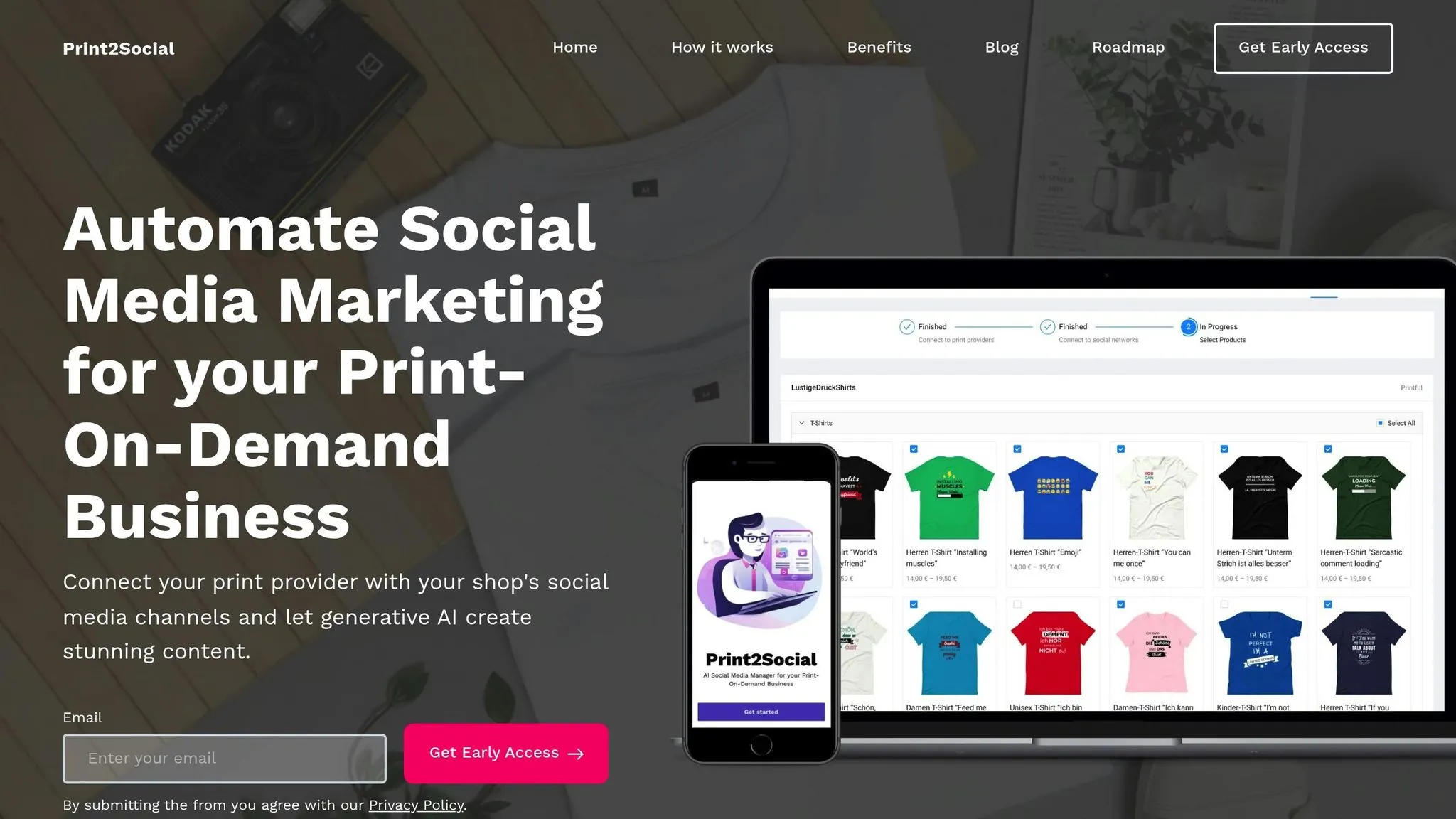
Print2Social is an AI-powered tool tailored to address the challenges of managing POD (Print-On-Demand) catalogs and fulfillment, all while keeping your community actively engaged.
With Print2Social, creating content becomes effortless. Its generative AI automatically transforms live POD data into eye-catching images and videos. By pulling product details directly from your connected POD providers, the platform crafts social media posts showcasing your designs and products without any manual input. The built-in scheduling system ensures posts go live at peak times, even when you’re busy handling other aspects of your business. A study by Forrester highlights that AI-powered automation can cut operational workloads by up to 40%, giving business owners more time to focus on product innovation and customer care.
Print2Social integrates directly with leading POD providers and e-commerce platforms, syncing your product catalogs and order details automatically. This ensures your content stays accurate and up-to-date. On the social media front, the tool connects with platforms like Facebook, Instagram, and X (formerly Twitter), allowing you to manage all your accounts from one centralized dashboard. This streamlined approach makes it easier to create meaningful, localized interactions with your audience.
If your POD business caters to American customers, Print2Social has you covered. It formats prices in U.S. dollars, follows the MM/DD/YYYY date format, and adapts content to American English spelling. Additionally, you can customize posts to align with U.S.-specific holidays, trends, and cultural moments, ensuring your messages resonate deeply. By aligning with local preferences - both linguistically and culturally - Print2Social helps you build stronger connections with your community.
Engagement is key, and Print2Social excels here too. The platform provides automated comment prompts and AI-generated responses to keep conversations flowing. Its analytics tools track crucial metrics like reach, likes, shares, comments, click-through rates, and follower growth. These insights help you identify what content drives the most interaction, enabling you to refine your strategy and strengthen relationships with your audience.
Print2Social empowers POD businesses to compete with larger brands by automating high-quality content creation and fostering meaningful engagement. Up next, we’ll dive into how tools like Midjourney can take creative expression to the next level for POD communities.
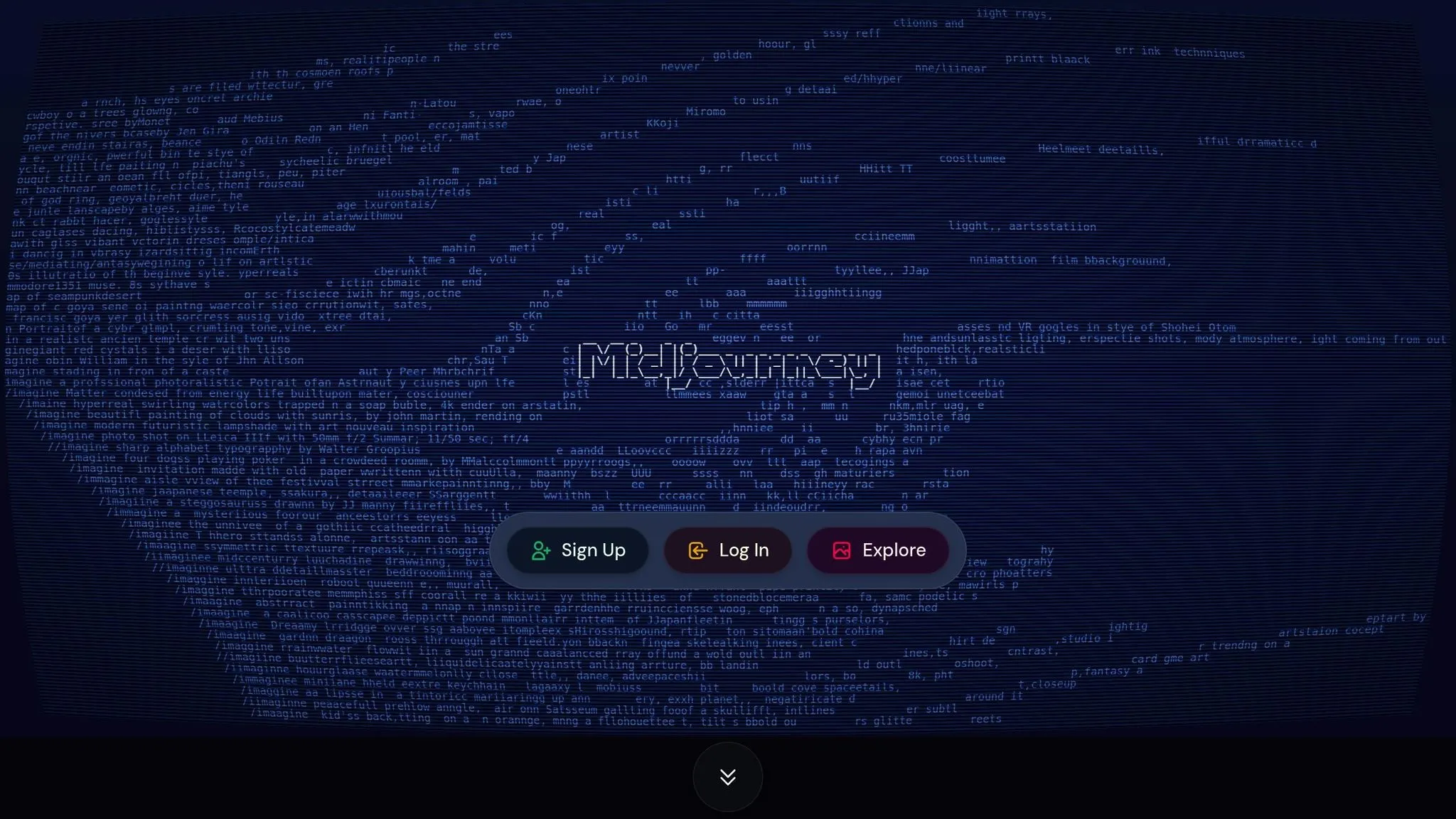
Midjourney transforms text prompts into striking artwork, giving print-on-demand (POD) businesses a wide range of design possibilities that ignite conversations within their communities.
Midjourney simplifies the process of creating stunning artwork from basic text prompts, making it a go-to tool for POD entrepreneurs who constantly need new design ideas. It takes detailed instructions and turns them into images across a variety of styles - whether you’re looking for something photorealistic or leaning toward abstract art. Users can quickly experiment with different ideas by generating, refining, and enhancing designs. This streamlined approach allows businesses to explore creative directions without relying heavily on external designers. It’s a game-changer for POD creators looking to stay agile and innovative.
Midjourney thrives within Discord servers, offering a built-in community space where POD creators can share their designs, receive feedback, and keep an eye on trending styles. Its public gallery acts as both a showcase and a source of inspiration, encouraging creators to learn from each other’s work. Many POD businesses use Midjourney-generated designs to engage their audience on social media. By sharing behind-the-scenes glimpses of their creative process, they encourage followers to interact, comment, and share, deepening community ties. Plus, the platform’s remix and variation tools make it easy to develop cohesive design collections that reflect customer preferences, ensuring a visually appealing and customer-driven product lineup.
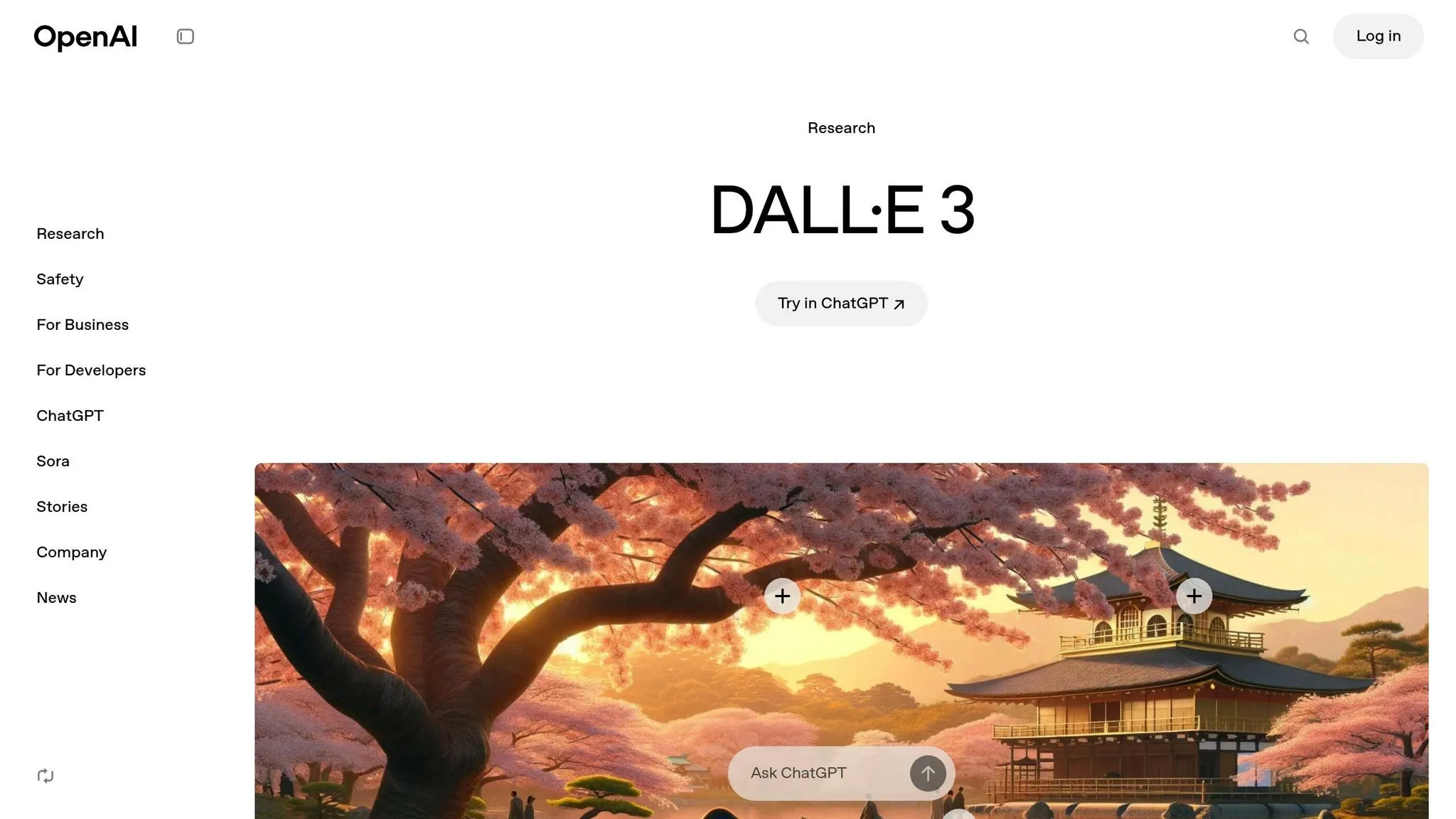
While Midjourney thrives on creative experimentation, DALL-E 3 focuses on precision, helping businesses craft visuals that perfectly align with their brand identity. This AI-powered image generator is a game-changer for print-on-demand businesses, enabling the creation of high-quality, tailored images from detailed text prompts.
DALL-E 3 transforms detailed text prompts into visuals that reflect your brand’s style and message. Its iterative design process lets creators start with a simple idea and refine it through multiple variations. This flexibility allows users to tweak concepts until the images fully align with their branding, making it easier to establish a cohesive visual identity without the guesswork.
DALL-E 3 fits seamlessly into existing creative workflows, making it an ideal tool for print-on-demand projects. Whether you’re designing apparel, wall art, or other products, the AI-generated visuals are ready for production. On top of that, these designs can be repurposed for promotional content on social media, ensuring your branding stays consistent across all platforms.
DALL-E 3 doesn’t just streamline design - it also helps build stronger connections with your audience. Its ability to quickly iterate designs means you can respond to customer feedback or adapt to seasonal trends in no time. Plus, the tool’s interactive features allow creators to share their design process with their audience, offering a behind-the-scenes look at how AI enhances creativity. This transparency can foster deeper engagement and make your community feel like part of the journey.
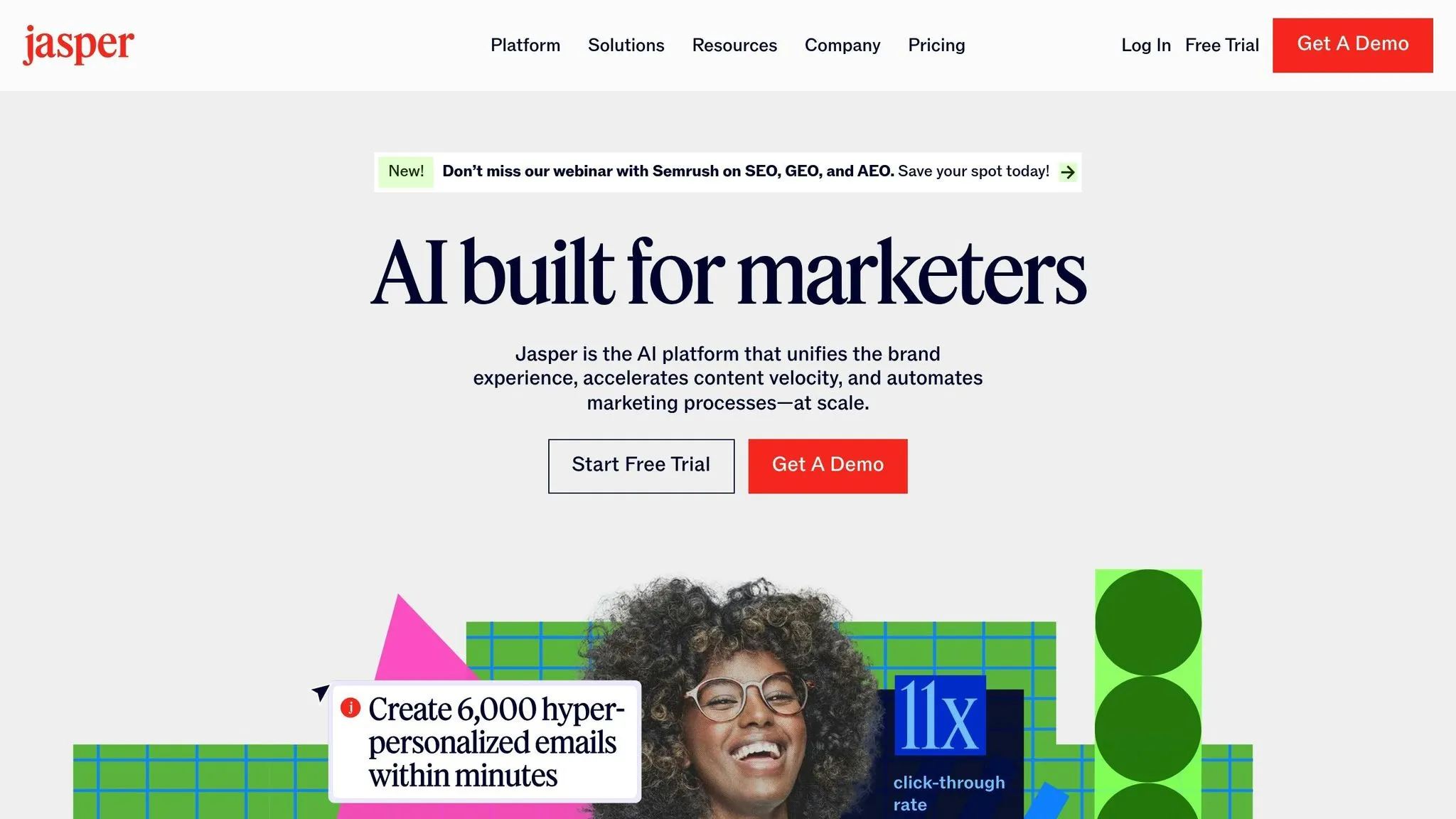
Jasper Art brings a burst of creativity to the table. This AI-driven art generator creates artwork at lightning speed, making it a great fit for print-on-demand products and digital marketing campaigns. Its quick turnaround allows businesses to fine-tune visuals and roll out fresh designs effortlessly, keeping their audience engaged and inspired.
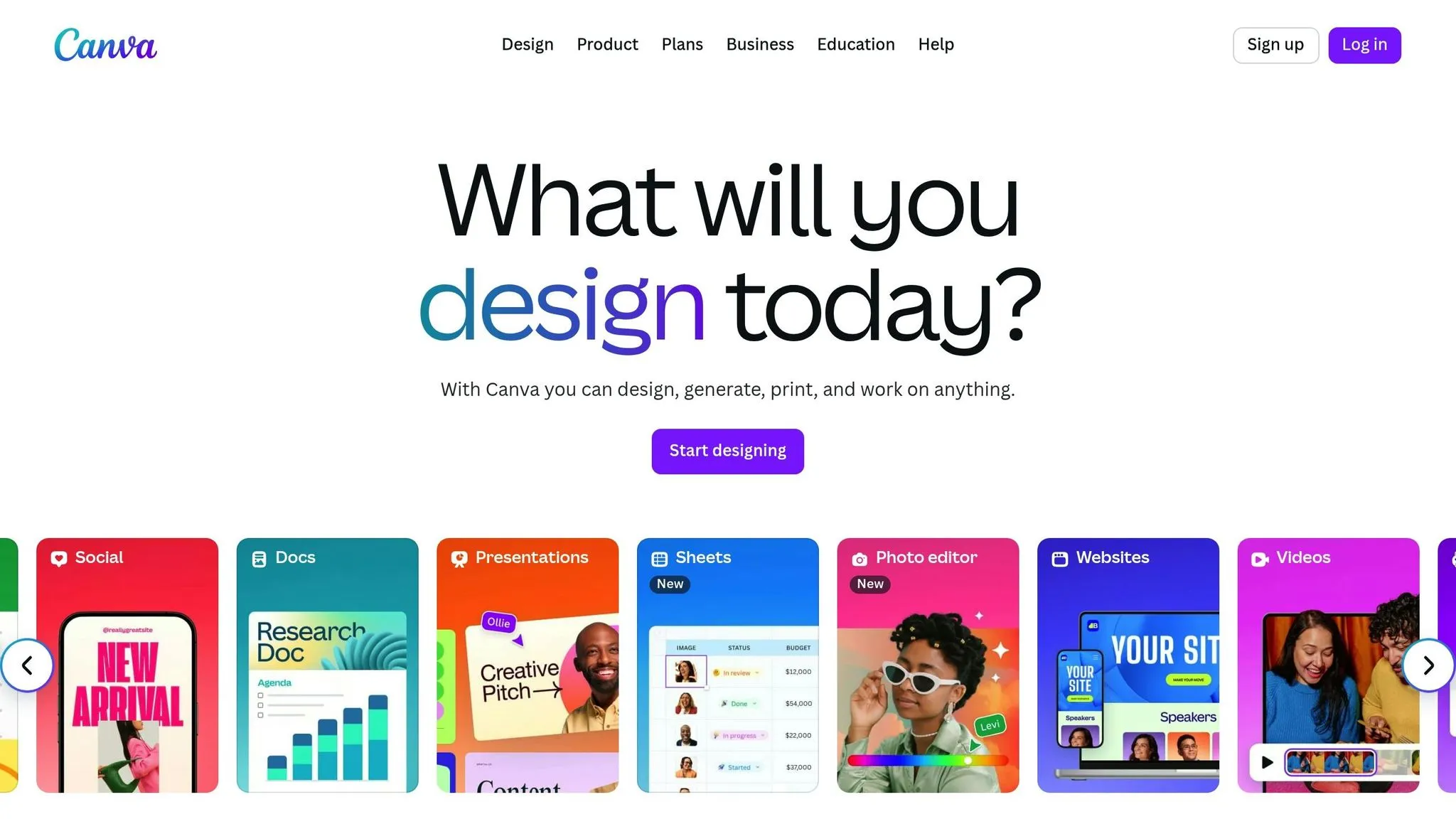
Canva is a user-friendly design platform packed with AI features and a wide range of templates, making it ideal for print-on-demand (POD) businesses - especially those without professional design expertise. Its Magic Design tool uses AI to create custom layouts from your images or text prompts, simplifying the design process for busy entrepreneurs.
Canva’s AI-powered tools make creating content faster and easier. Features like Text to Image, Background Remover, and Magic Resize allow you to:
- Turn text prompts into unique visuals.
- Clean up product images for a polished look.
- Adapt designs to fit any social media format effortlessly.
The Brand Kit feature keeps your marketing materials consistent by storing your brand’s colors, fonts, and logos in one place. On top of that, Canva’s Content Planner lets you schedule posts directly to platforms like Facebook and Instagram, ensuring a steady stream of promotional content even when other business tasks demand your attention.
Canva connects seamlessly with platforms like Facebook, Instagram, Twitter, LinkedIn, and Pinterest, allowing you to publish designs directly without leaving the interface. Its Apps marketplace also integrates with tools like Google Drive, Dropbox, and several stock photo services, keeping all your creative resources at your fingertips.
For POD businesses, Canva’s product mockup templates are a game-changer. They let you showcase your designs on items like t-shirts, mugs, and phone cases, creating professional-quality visuals that help customers see how your products will look. This not only enhances your promotional materials but also builds customer trust and boosts sales.
Canva makes collaboration easy with its real-time design tools. Team members or community managers can work together on projects, and the commenting system allows for quick feedback and revisions - all within the platform.
Want to grab attention on social media? Canva’s animation tools bring static designs to life, creating posts that stand out and drive engagement through likes, shares, and comments. For webinars, product launches, or educational content, the presentation maker is an invaluable tool. Plus, its video editing capabilities make it simple to produce behind-the-scenes clips, tutorials, and product demos that strengthen your connection with your audience.
From streamlining content creation to fostering community engagement, Canva equips POD businesses with the tools they need to succeed.
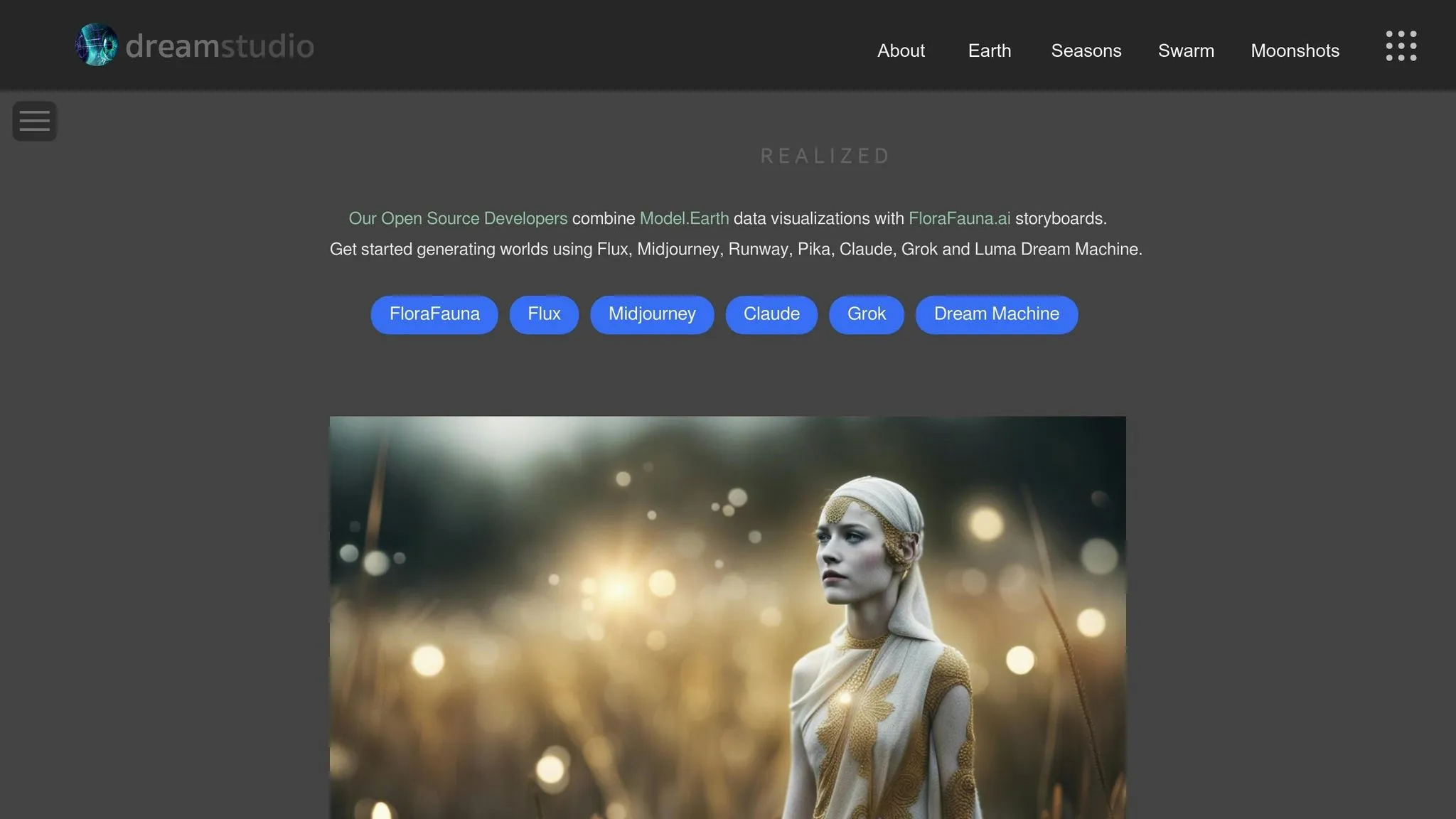
DreamStudio stands out as a powerful tool for creating text-to-image visuals, particularly for businesses in the print-on-demand (POD) space. By leveraging Stable Diffusion technology, it transforms text descriptions into original, high-quality images - perfect for entrepreneurs looking to produce eye-catching and unique artwork.
At the heart of DreamStudio’s capabilities is its text-to-image generation feature. Simply input a detailed prompt - like “minimalist mountain landscape in watercolor” - and the platform produces stunning visuals tailored to your description.
DreamStudio operates on a pay-per-use credit system, meaning you only pay for the images you create. It also offers the ability to generate multiple variations of a concept, giving you flexibility and creative options without committing to a single design.
DreamStudio’s API connects seamlessly with e-commerce platforms such as Shopify and WooCommerce, making it easier to upload personalized product images directly to your store listings. This integration simplifies tasks like creating mockups and promotional visuals, saving time and effort while enhancing your product presentation.
For social media marketing, DreamStudio integrates with platforms like Twitter, Instagram, Slack, Microsoft Teams, and Discord. These connections allow for automated content sharing and real-time collaboration, ensuring your team can create, refine, and post content efficiently across multiple channels.
DreamStudio’s compatibility with Discord and Microsoft Teams makes it an excellent choice for brands focused on community-building. Whether you’re creating custom visuals for community challenges, seasonal promotions, or member appreciation posts, the platform helps keep your audience engaged with fresh, dynamic content.
Its on-demand image creation capabilities make responding to trending topics or audience requests quick and straightforward. With real-time collaboration tools, you can generate and refine multiple design options based on feedback, ensuring your visuals resonate with your community and align with your brand’s goals.
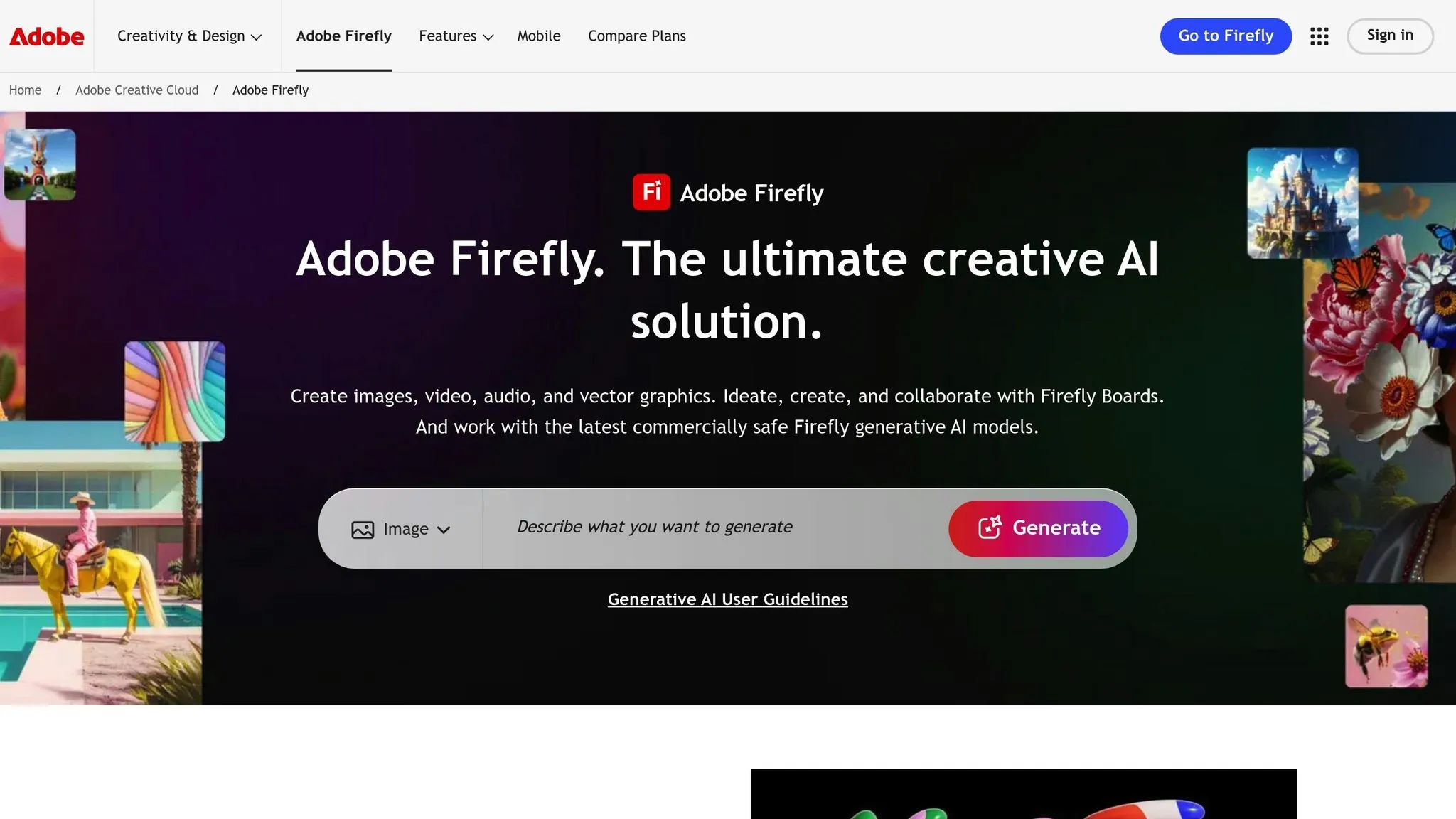
Adobe Firefly is an AI-driven tool designed to help print-on-demand businesses create eye-catching visuals. It transforms simple text prompts into stunning designs, perfect for merchandise like apparel, posters, and home decor.
The tool allows for quick design experimentation, generating multiple visuals in no time. This makes it easier to gather audience feedback and refine your creations, helping you connect better with your community and improve engagement.
What’s more, Firefly works seamlessly with Adobe Creative Cloud. This integration lets you polish your designs using professional-grade tools, ensuring your brand’s look stays consistent across products and marketing materials. Up next, we’ll look at more tools that can amplify your community engagement efforts.
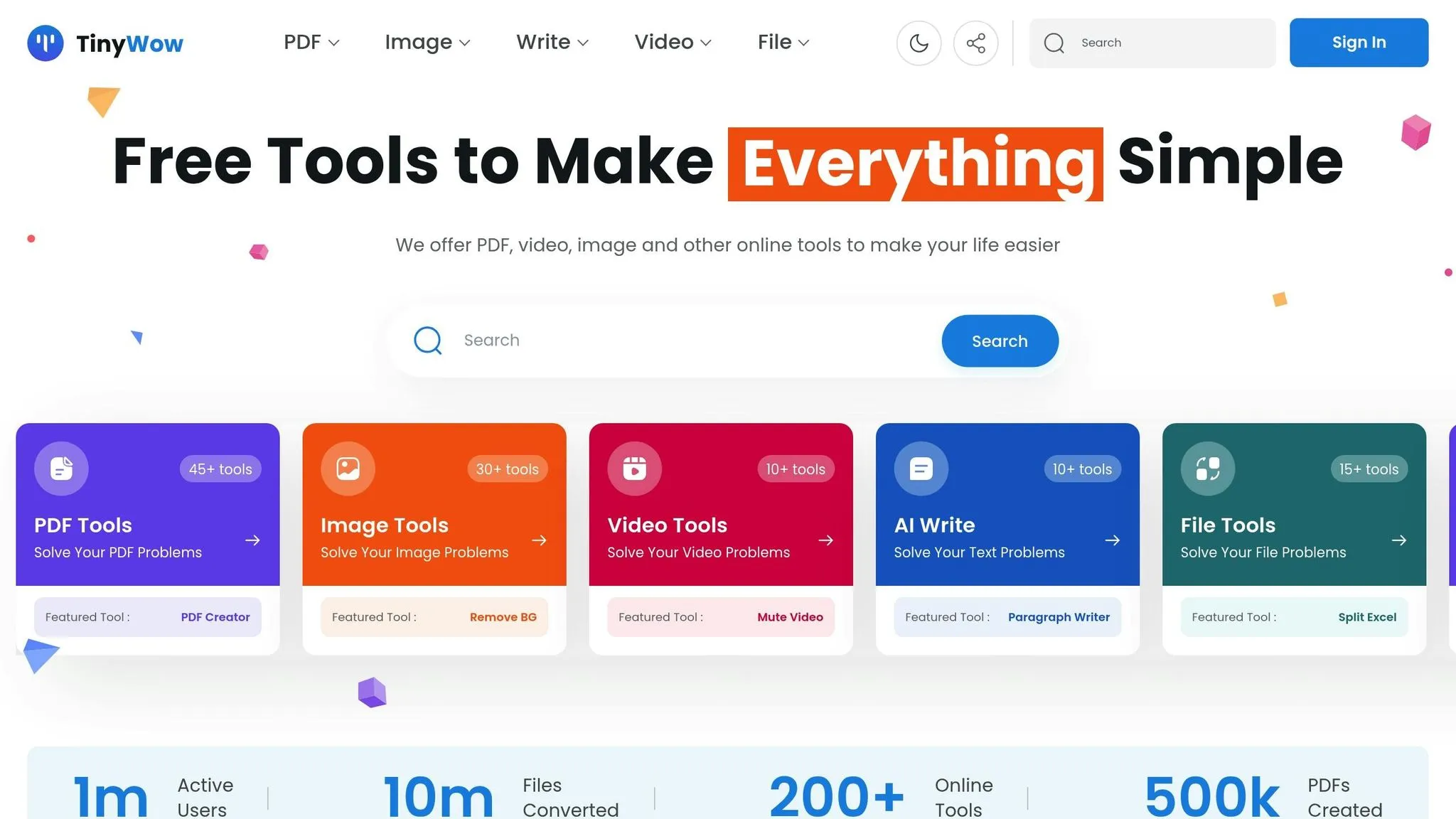
TinyWow is a free, browser-based toolkit packed with handy tools to help print-on-demand businesses polish and prepare their visual content. With its straightforward interface, it simplifies tasks like background removal, PDF editing, and image compression - making it easier to create eye-catching promotional materials for your store.
TinyWow’s background removal tool is perfect for cleaning up product images by eliminating unwanted distractions. Its PDF editing tools are ideal for putting together polished product catalogs, newsletters, or lookbooks, helping you present your marketing materials in a professional and organized way.
The image compression tool reduces file sizes while keeping quality intact, ensuring your website and social media pages load quickly. Since TinyWow runs entirely in your browser, it offers a hassle-free way to fine-tune your visual assets, giving you more time to connect with your audience. These tools provide a solid foundation for building even stronger engagement strategies.
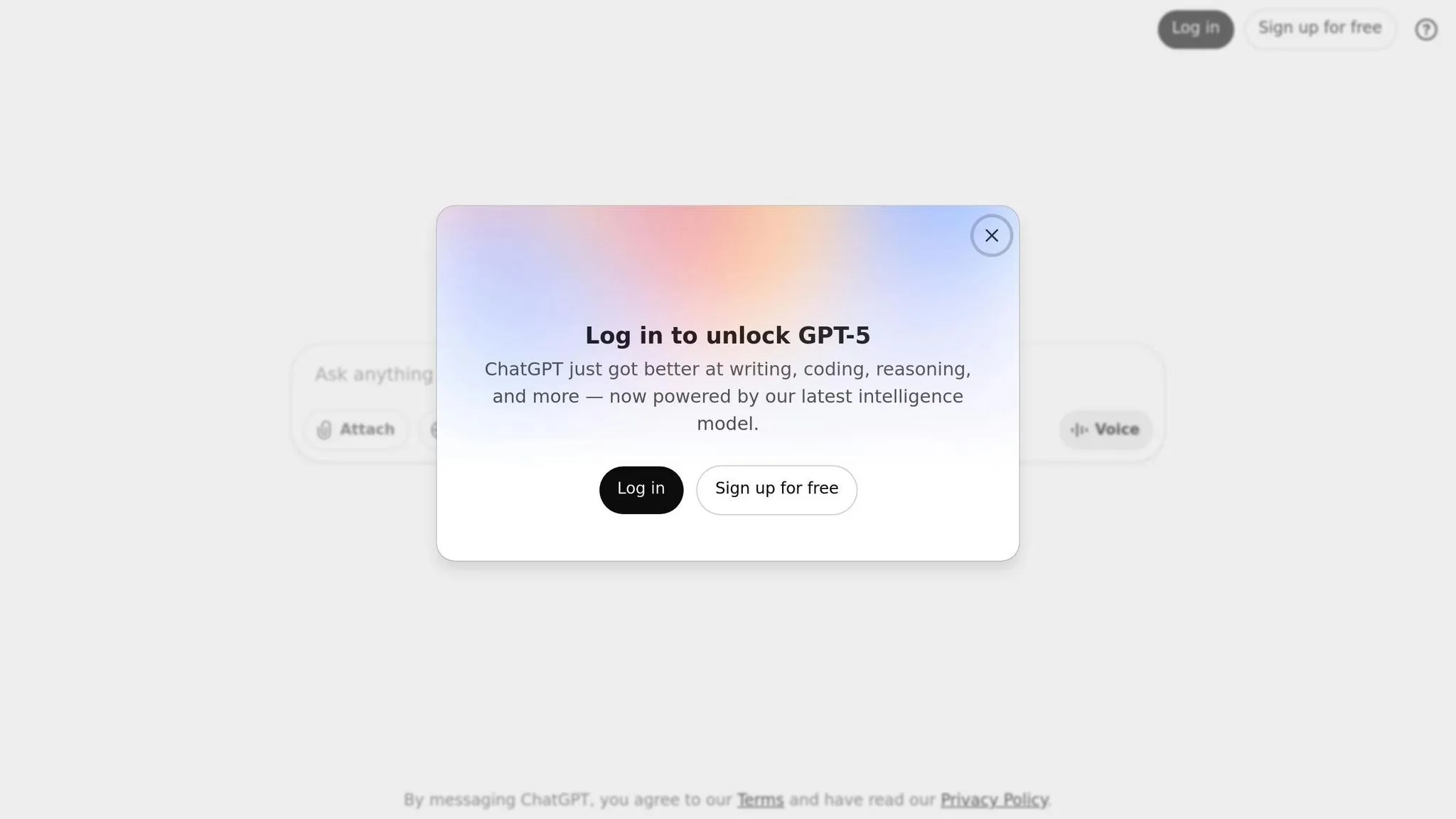
When it comes to AI tools that boost community engagement, ChatGPT stands out as a game-changer for POD (print-on-demand) businesses. It simplifies content creation and customer interaction, allowing entrepreneurs to stay connected with their audience without spending countless hours crafting messages.
ChatGPT shines in its ability to generate content quickly and effectively. Whether you need product descriptions that emphasize features and benefits, SEO-friendly blog posts to attract organic traffic, or social media captions that spark engagement, this tool has you covered. Its ability to maintain a consistent brand voice ensures that everything from customer emails to product listings feels cohesive and professional. Just provide a few key details, and ChatGPT delivers polished copy in minutes.
Keeping your community engaged is easier with ChatGPT. It can create discussion prompts, Q&A materials, and even personalized responses to connect with your audience. By training the tool with your brand guidelines and frequently asked questions, you can automate responses to common inquiries, improving customer satisfaction while freeing up time for other tasks.
In fact, AI-powered automation like this can reduce workloads by up to 40%, giving managers more time to focus on scaling their business.
For businesses targeting U.S. customers, ChatGPT adapts effortlessly. It uses U.S. English, formats prices in dollars, and aligns with American cultural preferences. Whether you’re planning a Fourth of July sale, a Labor Day promotion, or back-to-school campaigns, ChatGPT ensures your messaging resonates with U.S. audiences by factoring in seasonal trends and regional preferences.
ChatGPT offers a free version with basic features, while the ChatGPT Plus plan - priced at $20/month - provides priority access and advanced capabilities. It also integrates seamlessly with tools like Print2Social, enabling you to create a smooth workflow for both written and visual marketing content. Up next, we’ll dive into how TPOP can further elevate your POD content strategy.
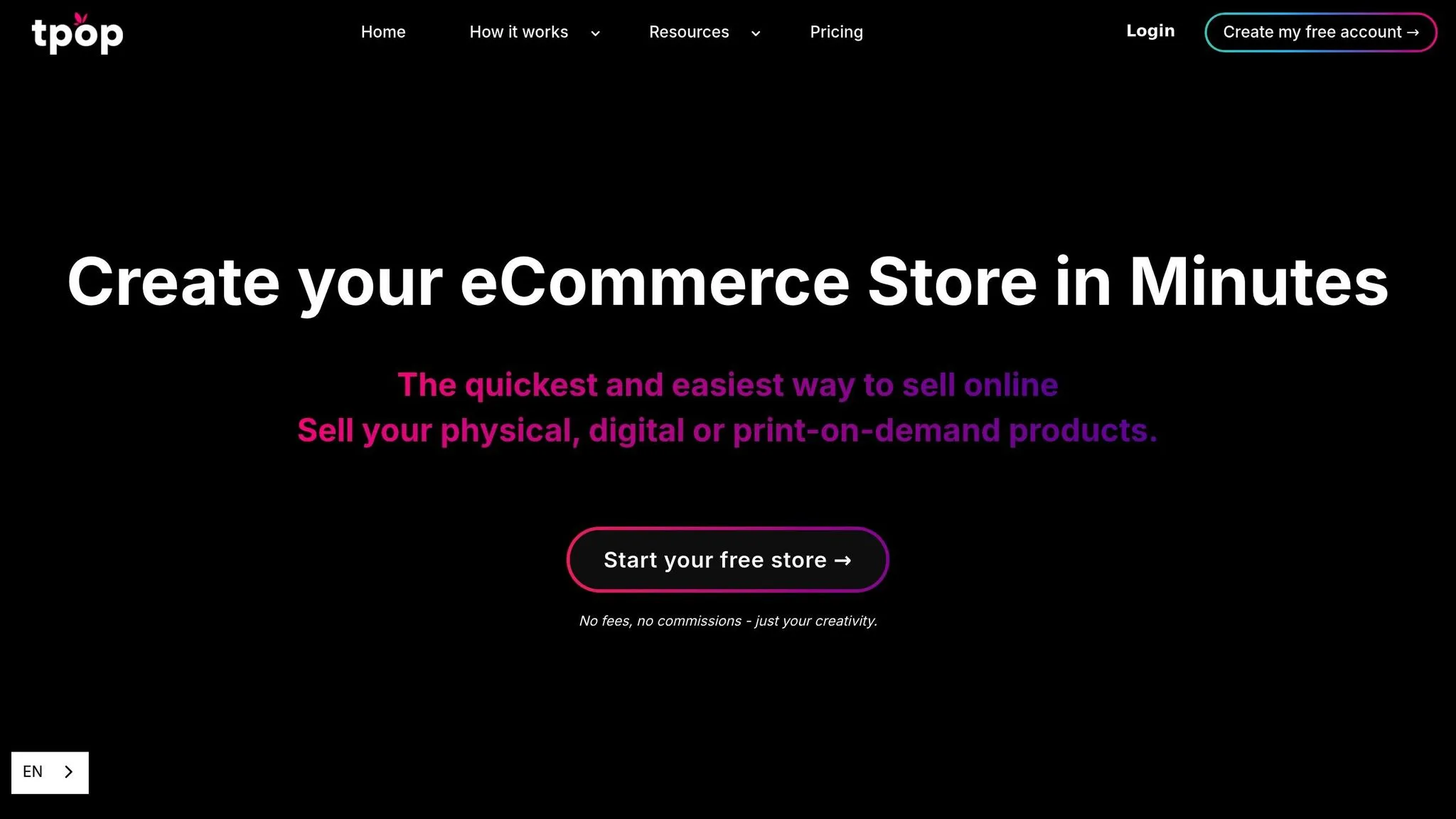
TPOP is a handy AI-driven platform designed to simplify catalog management and enhance community interaction for print-on-demand (POD) businesses. It automates catalog updates and connects seamlessly with social media platforms, making it easier to manage workflows and stay engaged with your audience. For more details, you can visit the official TPOP website.
This tool, like others we’ve covered, focuses on improving workflows and fostering meaningful community connections - key ingredients for success in the POD space.
Here’s a handy comparison of AI tools to help you decide which one fits your POD community engagement needs. The table below outlines their functions, benefits, U.S. market support, pricing, and ideal use cases.
Tool
Primary Function
Key POD Benefits
U.S. Market Support
Pricing Model
Best For
Print2Social
AI social media automation
Automated product promotion, direct provider integration, video creation
Full U.S. localization
Subscription-based
Complete social media automation
Midjourney
AI image generation
Custom designs, product mockups
English interface, USD pricing
Monthly subscription ($10–$60)
Creative design generation
DALL-E 3
AI image creation
Product visualization, marketing graphics
Full English support
Pay-per-use ($0.040–$0.120 per image)
High-quality product images
Jasper Art
Marketing-focused AI art
Brand-consistent visuals, marketing materials
U.S.-optimized content
Monthly plans ($39–$125)
Marketing campaign visuals
Canva
Design platform with AI
Template-based designs, social posts
Extensive U.S. templates
Freemium (Pro at ~$14.99/month)
Quick design creation
DreamStudio
Stable Diffusion interface
Artistic product designs, concept art
English interface
Credit-based (e.g., $10 for 1,000 credits)
Artistic design exploration
Adobe Firefly
Enterprise AI design
Professional-grade graphics, brand assets
Full U.S. business support
Integrated with Creative Cloud
Professional design work
TinyWow
Multi-purpose AI tools
Image editing, file conversion
Basic English support
Mostly free with ads
Quick utility tasks
ChatGPT
AI writing assistant
Product descriptions, social media copy
Excellent English capabilities
Free/Subscription at ~$20/month
Content writing and strategy
TPOP
Catalog management
Automated catalog updates, workflow optimization
Limited U.S. features
Custom pricing
Inventory management
- Streamlined Integration: Tools like Print2Social stand out for their direct integration with POD providers, eliminating the need for manual data entry. This is particularly useful for businesses looking to save time and reduce errors.
- Content Creation: Print2Social offers a unique edge by generating both images and videos featuring your actual products, which is crucial for POD sales. In contrast, tools like Canva rely on templates, and Midjourney creates artwork without product-specific context.
- Ease of Use: Platforms like Canva and TinyWow are beginner-friendly with intuitive interfaces, while DreamStudio and Midjourney may require a steeper learning curve. Print2Social strikes a balance with its combination of automation and customizable options.
- Scalability for Growth: For businesses aiming to scale, Adobe Firefly and Print2Social are equipped to handle enterprise-level workflows. On the other hand, tools like ChatGPT and TinyWow may struggle with high-volume demands as your operations expand.
Each tool offers distinct features tailored to specific needs, whether it’s automation, design, or content creation. Selecting the right one depends on your business goals and the level of integration and scalability you require.
AI tools are reshaping how POD businesses connect with their communities by streamlining workflows and producing personalized, impactful content. These tools take the grind out of manual tasks, allowing businesses to focus on creating meaningful interactions.
The key to success lies in selecting the right tools for your needs. For example, Print2Social simplifies social media management with seamless POD integration, Midjourney and DALL-E 3 craft custom visuals, Canva offers user-friendly design templates, and ChatGPT helps generate compelling copy. Start small - pick one or two tools that address your biggest challenges, and gradually expand your toolkit as your comfort and needs grow.
When choosing tools, consider your budget and technical expertise. Free options like TinyWow and ChatGPT work well for smaller operations, while premium services like Print2Social or Adobe Firefly can help scale your efforts efficiently.
It’s important to remember that AI is not about replacing human creativity but enhancing it. These platforms handle repetitive tasks and spark ideas, giving you more time to focus on strategy, customer relationships, and fostering genuine connections. By blending AI’s efficiency with human insight, you can build a strong foundation for lasting community engagement.
Use these strategies to refine your approach and keep evolving in step with new innovations. AI offers powerful tools, but it’s your creativity and connection with your audience that will truly make the difference.
AI tools such as Print2Social simplify how print-on-demand (POD) businesses manage their social media presence by automating essential tasks. With the help of generative AI, these tools create visually appealing images and videos that highlight your products, making it easier to grab attention and encourage interaction.
On top of that, AI-driven scheduling ensures your posts go live at the best possible times, increasing their reach and engagement. By handling both content creation and posting, tools like Print2Social save you time while helping you maintain a steady online presence. This makes it simpler to connect with your audience and expand your brand’s reach.
AI tools like Midjourney and DALL-E 3 bring powerful design capabilities to the table, making it easier than ever to create custom visuals for print-on-demand (POD) products. These tools work by using generative AI to craft unique, high-quality images based on your specific input. The result? Eye-catching designs that can be tailored to perfectly match your audience’s preferences.
For POD businesses, these tools are game-changers. They can be used to create product mockups, promotional materials, or even entirely new design ideas - all while saving you time and effort. Plus, with AI on your side, it’s simple to experiment with different styles and adapt to trends, keeping your product lineup fresh and visually appealing.
When choosing an AI tool for your print-on-demand business, it’s all about finding features that help you save time and work smarter. Opt for tools that can automatically generate engaging, on-brand content - think posts, images, or videos that showcase your products effectively. It’s also crucial that the tool integrates effortlessly with your store, print-on-demand providers, and social media platforms to keep everything running smoothly.
Another key factor? Automation features. Look for tools that can handle tasks like scheduling posts and managing customer interactions. These functions can simplify your marketing process, giving you more time to focus on connecting with your audience and growing your business efficiently.










